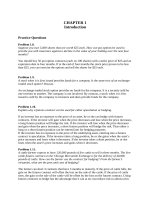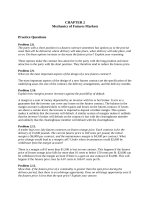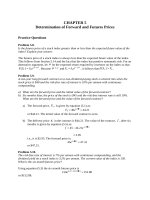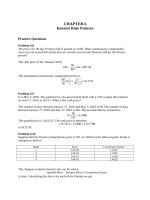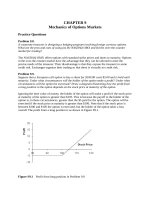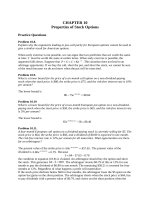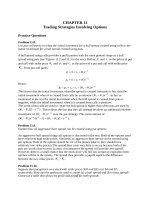Test bank fundamentals of futures and options markets 7e by hull chapter 3
Bạn đang xem bản rút gọn của tài liệu. Xem và tải ngay bản đầy đủ của tài liệu tại đây (33.57 KB, 2 trang )
Test Bank: Chapter 3
Hedging Strategies Using Futures
1. The basis is defined as spot minus futures. For a short hedger basis strengthens
unexpectedly. Which of the following is true (circle one)
(a) The hedger’s position improves.
(b) The hedger’s position worsens.
(c) The hedger’s position sometimes worsens and sometimes improves.
(d) The hedger’s position stays the same.
2. On March 1 the price of oil is $60 and the July futures price is $59. On June 1 the
price of oil is $64 and the July futures price is $63.50. A company entered into a
futures contracts on March 1 to hedge the purchase of oil on June 1. It closed out its
position on June 1. After taking account of the cost of hedging, what is the effective
price paid by the company for the oil? _ _ _ _ _ _
3. On March 1 the price of gold is $1,000 and the December futures price is $1,015. On
November 1 the price of gold is $980 and the December futures price is $981. A gold
producer entered into a December futures contracts on March 1 to hedge the sale of
gold on November 1. It closed out its position on November 1. After taking account of
the cost of hedging, what is the effective price received by the company for the gold?
______
4. Suppose that the standard deviation of monthly changes in the price of commodity A
is $2. The standard deviation of monthly changes in a futures price for a contract on
commodity B (which is similar to commodity A) is $3. The correlation between the
futures price and the commodity price is 0.9. What hedge ratio should be used when
hedging a one month exposure to the price of commodity A? _ _ _ _ _ _
5. A company has a $36 million portfolio with a beta of 1.2. The futures price for a
contract on the S&P index is 900. Futures contracts on $250 times the index can be
traded. What trade is necessary to achieve the following. (Indicate the number of
contracts that should be traded and whether the position is long or short.)
(i)
Eliminate all systematic risk in the portfolio _ _ _ _ _ _ _ _ _ _
(ii)
Reduce the beta to 0.9 _ _ _ _ _ _ _ _ _ _
(iii)
Increase beta to 1.8 _ _ _ _ _ _ _ _ _ _
6. Futures contracts trade with every month as a delivery month. A company is hedging
the purchase of the underlying asset on June 15. Which futures contract should it use
(circle one)
(a) The June contract
(b) The July contract
(c) The May contract
(d) The August contract
7. Which of the following is true (circle one)
(a) The optimal hedge ratio is the slope of the best fit line when the spot price (on the
y -axis) is regressed against the futures price (on the x -axis).
(b) The optimal hedge ratio is the slope of the best fit line when the futures price (on
the y -axis) is regressed against the spot price (on the x -axis).
(c) The optimal hedge ratio is the slope of the best fit line when the change in the spot
price (on the y -axis) is regressed against the change in the futures price (on the x axis).
(d) The optimal hedge ratio is the slope of the best fit line when the change in the
futures price (on the y -axis) is regressed against the change in the spot price (on
the x -axis).
8. Tailing the hedge is (circle one)
(a) A strategy where the hedge position is increased at the end of the life of the hedge
(b) A strategy where the hedge position is increased at the end of the life of the
futures contract
(c) A more exact calculation of the hedge ratio when forward contracts are used for
hedging
(d) None of the above
